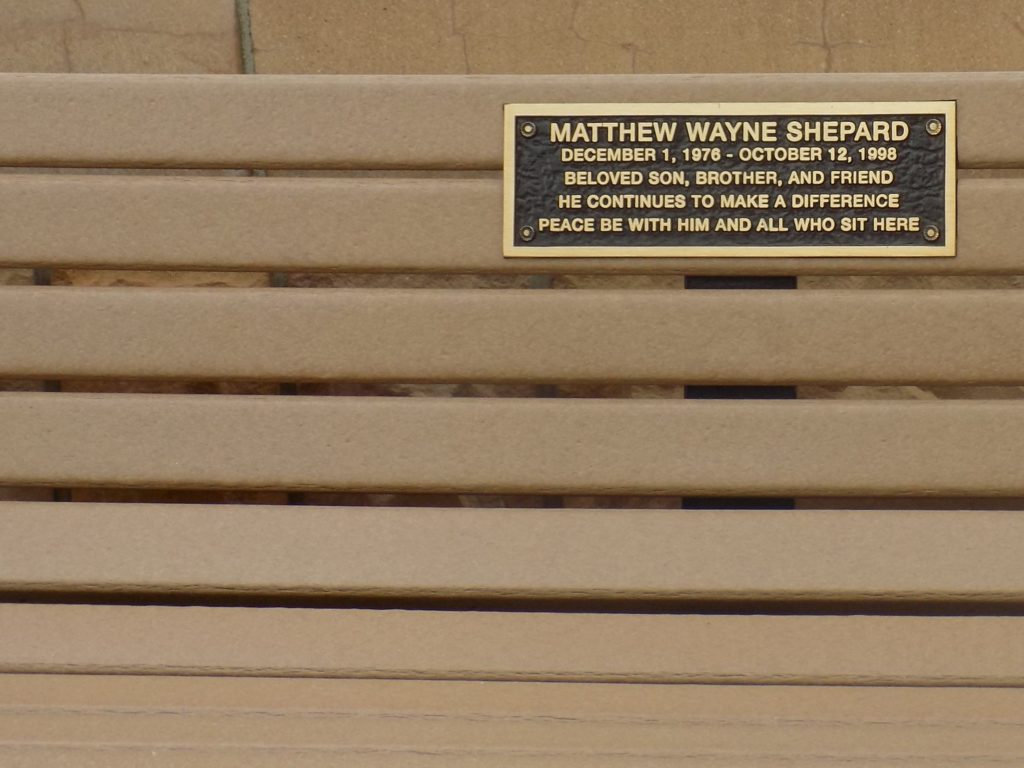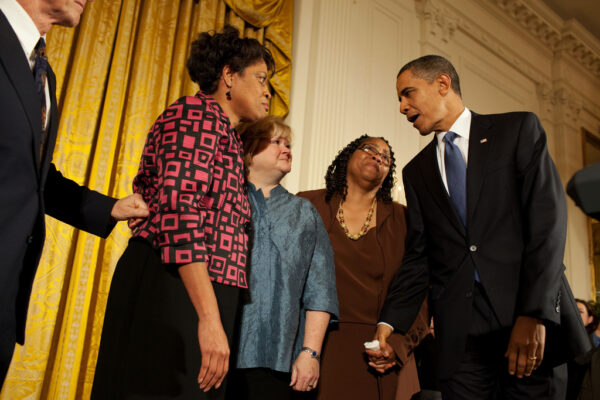Far from an angel.
Two benches sit on Quealy Plaza in front of the Arts and Humanities building on the campus of the University of Wyoming in Laramie. As you exit the building, the one on the right is distinguished by this plaque:.

For those unfamiliar with his story or those who don’t recall it, here’s how it’s portrayed on the website of the foundation that bears his name:.
The story of Matthew Shepard began on December 1, 1976 when he was born to Judy and Dennis Shepard in Casper, Wyoming. He went to public school in Casper until his junior year of high school when he moved with his family to Saudi Arabia. Matt had to finish his high school education at The American School in Switzerland because there were no American high schools in Saudi Arabia at the time. In both high schools, he was elected by his peers to be a peer counselor. He was easy to talk to, made friends easily and actively fought for the acceptance of all people.
Matt had a great passion for equality. His experiences abroad fueled his love for travel and gave him the chance to make many new friends from around the world. Matt’s college career eventually took him back to Wyoming where he studied political science, foreign relations and languages at the University of Wyoming in Laramie.
The horrific events that took place shortly after midnight on October 7, 1998 would become one of the most notorious anti-gay hate crimes in American history and spawned an activist movement that, more than a decade later, would result in passage of the Matthew Shepard and James Byrd Jr. Hate Crimes Prevention Act, a federal law against bias crimes directed at lesbian, gay, bisexual or transgender people. Two men, Aaron McKinney and Russell Henderson, abducted Matt and drove him to a remote area east of Laramie, Wyoming. He was tied to a split-rail fence where the two men severely assaulted him with the butt of a pistol. He was beaten and left to die in the cold of the night. Almost 18 hours later, he was found by a bicyclist who initially mistook him for a scarecrow.
Matt died on October 12 at 12:53 a.m. at Poudre Valley Hospital in Fort Collins, Colorado with his family by his side. His memorial service was attended by friends and family from around the world and garnered immense media attention that brought Matt’s story to the forefront of the fight against bigotry and hate.
The life and death of Matthew Shepard changed the way we talk about, and deal with, hate in America. Since his death, Matt’s legacy has challenged and inspired millions of individuals to erase hate in all its forms. Although Matt’s life was short, his story continues to have a great impact on young and old alike. His legacy lives on in thousands of people who actively fight to replace hate with understanding, compassion, and acceptance.

President Barack Obama greets Louvon Harris, left, Betty Byrd Boatner, right, both sisters of James Byrd, Jr., and Judy Shepard, center, mother of Matthew Shepard, following his remarks at a reception commemorating the enactment of the Matthew Shepard and James Byrd Jr. Hate Crimes Prevention Act, in the East Room, of the White House, October 28, 2009. [Official White House Photo by Pete Souza.]
This portrayal of Matthew Shepard as a martyred victim of a hate crime is certainly the version of his personal history that his friends, family, and some staunch advocates in the LGBTQ community have succeeded in cementing in the public’s mind.
However, as is often the case when you deepen your search, a subtler, more complex, and at times less flattering picture of Shepard emerges while the motives behind the events that led to his horrific murder become more elusive.
Most of the information that follows is culled from various summaries and reviews of Stephen Jimenez’s book The Story of Matt: Hidden Truths About the Murder of Matthew Shepard. (I haven’t read the book so I urge you to consider that as you read this and the subsequent post.) Jimenez, who first went to Laramie to gather information for a possible screenplay about the incident, is an investigative journalist who, early in this process, discovered a very different Matthew Shepard from the one who had been portrayed in the media. He ultimately interviewed more than 100 people over 13 years before publishing his book. I found no indication that Jimenez, a gay man himself, has an anti-LGBTQ bias.
People who follow American culture and politics are likely aware that the drug scourge of the day is labeled “the opioid crisis.” But in America, we always seem to be facing one drug scourge or another be it LSD and marijuana in the sixties and seventies or the “crack cocaine epidemic” of the mid-eighties. The AMC show Breaking Bad might connect the late nineties or early parts of this century with a methamphetamine or crystal meth crisis. According to Jimenez’s reporting, this drug might have played a role equal to or greater than Shepard’s sexuality in the commission of his brutal murder.
I won’t report the queasiness inducing details of Shepard’s murder but after being beaten and left for dead tied to a fence for nearly a day before a passing cyclist spotted him, he clung to life in the hospital for nearly five days. As early as that first night and over the ensuing days, two of his friends, Alex Troutt and Walt Bolden, contacted the Associated Press and several gay rights organizations portraying the incident as a hate crime – painting a picture of a pair of homophobic rednecks walking into a bar, spotting and targeting a gay man, then abducting and killing him.
By the time Shepard died the narrative had been set. A story in The Advocate, published some years later states, “As JoAnn Wypijewski wrote in a brilliant 1999 piece for Harper’s Magazine, ‘Press crews who had never before and have not since lingered over gruesome murders of homosexuals came out in force, reporting their brush with a bigotry so poisonous it could scarcely be imagined.'”
Contributing to a sort of political perfect storm, Bill Clinton, who had instituted the controversial “Don’t ask. Don’t tell” policy for gays in the military and who had signed the Defense of Marriage Act two years earlier, felt a need to mend fences with the LGBTQ community. The press portrayal and the need of an administration to shore up its relations with the gay rights community sealed Matthew Shepard’s image as a gay martyr and made him the poster boy for pressing ahead with a hate crimes law.
But a deeper investigation reveals that his life and murder wasn’t quite as clear cut as these early portrayals made it seem. The next post should add another layer to the picture.